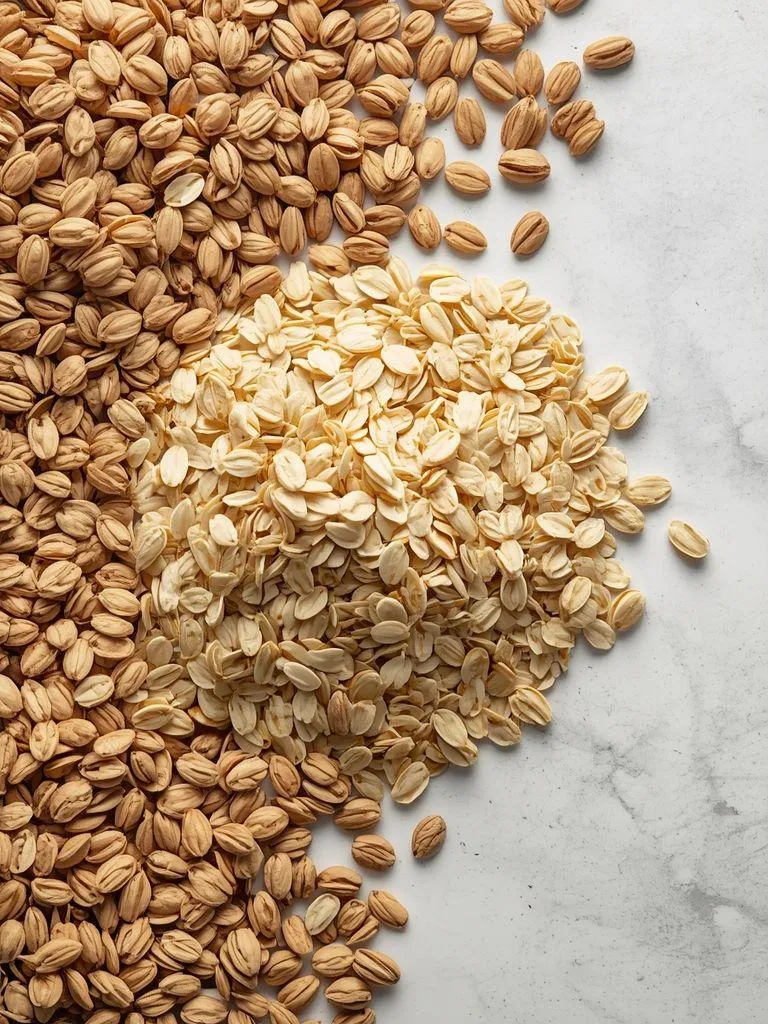- Anna Schmidt
- October 24, 2025
- 9min.
- Report
Is a Gluten-Free Diet Healthy or Merely Trendy?
Gluten, a component of cereals, has gained significant popularity in recent years as a cause of many ailments. However, there are only a few cases where a gluten-free diet is justified, not just in celiac disease. Gluten is present in the seeds of wheat (gliadin), rye (hordein), and barley (secalin). It can also occur in oats, where it is often contaminated with other cereals. In Poland, certified oat products produced in Finland are available, which guarantee that they are gluten-free. Although gluten is not toxic, a gluten-free diet has become extremely popular. It has been attributed with weight loss and alleviation of various ailments. Is this true?
Table of Contents
1. Gluten-free nutrition – when is it necessary?
Individuals suffering from celiac disease and gluten allergy should adhere to a gluten-free nutrition. The main difference between these two conditions lies in the mechanisms that cause the symptoms. In the case of gluten allergy, IgE antibodies are present, while in celiac disease, antibodies against endomysium and tissue transglutamine are present. Furthermore, in the case of celiac disease, intestinal villi atrophy is observed. It is important to note that the gluten-free nutrition should be adhered to for life by individuals with celiac disease. In the case of gluten allergy, the elimination of gluten does not have to be lifelong, but only for a certain period, after which attempts can be made to reintroduce gluten into the diet. There is also a controversial health unit that requires a specific diet – non-celiac gluten sensitivity.2. Unrecognized hypersensitivity to gluten
Unrecognized hypersensitivity to gluten (UHG) is a commonly used and understood term, but so far there is no consensus among doctors and scientists as to its actual existence and possible diagnosis. UHG can be characterized by the occurrence of certain symptoms (abdominal pain, persistent bloating, sleep disorders, fatigue, diarrhea, headache, muscle pain, joint pain, skin changes, weight loss) several hours or days after ingestion of products containing gluten and their disappearance after the introduction of a gluten-free diet. The occurrence of UHG can only be considered after excluding celiac disease and gluten allergy. However, some scientists still doubt the existence of UHG, claiming that it is not a separate disease entity, but only a feature of the irritable bowel syndrome. If we want to follow a gluten-free diet, it is important to understand the strict rules of its application.3. Gluten-free diet – Undesirable food products
In the case of a gluten-free diet, it is not permitted to consume products containing gluten or those contaminated with it. It is necessary to exclude all products produced using wheat, rye, barley and oats. In the case of oats, although it is a naturally gluten-free grain, it can be heavily contaminated with other cereals, so it is also not suitable for a gluten-free diet for sick people. We must give up wheat flour, rye flour, pasta and other products made from these flours, such as bread, oat flakes, barley, wheat bran, gluten-containing biscuits, barley, pearl, barley, barley coffee, certain types of alcohol (beer is produced from barley malt) and all products in which gluten is hidden in the form of food additives. Is it possible at all to have something to eat?4. Gluten-free diet - allowable products
Naturally gluten-free cereals include maize, millet, proso and rice. A person with celiac disease can consume buckwheat, buckwheat flour, buckwheat pasta, oat bran, rice, rice flakes, cornmeal, potatoes, tapioca, amaranth, cassava, vegetables and fruits, meat, fish, oils, nuts and seeds. Contrary to the expectations of people with celiac disease, manufacturers of gluten-free products have emerged in the market. In stores, one can find gluten-free products marked with the international symbol of a crossed-out ear of corn, indicating that these products are safe for people with celiac disease because they contain no more than 20 mg of gluten per kilogram. However, despite the fact that these products are safe, their composition is not always obvious, so one must be careful.5. Are we truly on a gluten-free diet – what to look out for?
There is a wide range of foods available on the market that do not naturally contain gluten but can contain it if it has been intentionally added due to its technological properties. Such products can pose a particular risk to people suffering from celiac disease. Here are some products that may be a source of gluten, although this is not always obvious: – baking powder, flavored sugar, creams for cakes, – wafers, – muesli, – processed meats (may contain starch), minced and packaged meats, – black pudding, pâté, – cutlets, – yogurts, buttermilk, cream, cheeses, milk products, puddings, – fruit and vegetable preserves, spice and herb blends, – chocolate and chocolate products, candies, chewing gum, ice cream, – mayonnaises, ketchups, and other ready-made sauces, – instant products, – medications. It is not possible to list all the potentially hazardous products, so it is important to know how to read labels. Fortunately, manufacturers are required to provide information on the packaging about the gluten content of a product. If starch is listed on the label in the ingredients list, you should pay attention to where it comes from. This information should also be indicated on the packaging (e.g., wheat/corn starch). The best diet is one that is based on natural products. Although there are gluten-free breads, pastas, and cookies on the market, they do not always meet the requirements of our palate. Gluten is a component of grains that gives the products made from them the right structure. The following sample meal plan shows that our menu can be based on naturally gluten-free products.6. Morning meal with barley groats, apple and cinnamon
Morning meal with barley groats, apple and cinnamon Ingredients: - barley groats 50 g, - milk 1.5% 150 ml, - apple 80 g, - banana 50 g, - Italian nuts 10 g, - cinnamon to taste. Rinse the barley groats with hot water several times so that it is not bitter. Peel the apple and cut it into small cubes. Bring the milk to a boil, add the barley groats and sliced banana. Reduce the heat and cook the whole for about 10 minutes, stirring frequently. Then add the chopped apples and cinnamon and cook for a few more minutes until the barley groats are soft. Transfer the mixture to a bowl and decorate with nuts. Nutritional value: - Protein: 13.5 g, - Fat: 10.3 g, - Carbohydrates: 63 g, - Fiber: 6.9 g. Total energy value: 411 kcal.7. Second breakfast, a cocktail comprised of spinach, pear and banana
Vitamins and nutrients in one dish. A cocktail made of fresh spinach, pear and banana. Ingredients: – Natural yogurt 150 ml, – Fresh spinach 25 g, – Pear 65 g, – Banana 50 g. Peel the fruits. Then put all the ingredients in a blender and blend until a smooth mass is obtained. Best to consume immediately after preparation. Nutritional value: – Protein: 8.1 g, – Fat: 3.4 g, – Carbohydrates: 28.4 g, – Fiber: 2.8 g. Total energy value: 183 kcal.8. Afternoon Luncheon
The ingredients for the soup are: celery 30 g, carrots 25 g, parsley 20 g, vinegar 15 g, pickled cucumber 70 g, garlic 3 g, white rice 20 g, natural yogurt 30 g, bay leaf, English green, salt, black pepper, copper. In the pot, boil the water. Add the bay leaf, English green and garlic. Peel the vegetables, grate them on a coarse grater and add them to the pot. Cook the soup for about 20 minutes. Then add rice and coarsely grated cucumbers (with juice). Add copper, season with salt and pepper, and stir the soup with yogurt. Nutritional value: protein: 5.2 g, fat: 1.1 g, carbohydrates: 23 g, fiber: 4.6 g. Total energy value: 131 kcal. The ingredients for the baked cod are: cod fillet 100 g, mozzarella 50 g, cherry tomatoes 100 g, potatoes 150 g, olive oil 10 g, broccoli 100 g, Herbes de Provence, salt, black pepper, copper. Preheat the oven to about 180°C. Peel the potatoes and cook them in lightly salted water. Wash the cod fillets, dry them with a paper towel, and place them on aluminum foil. Wash the cherry tomatoes and cut them into slices. Cut the mozzarella into slices. Brush the fillet with olive oil and sprinkle with salt, pepper, and Herbes de Provence. Arrange the tomato and mozzarella slices. Wrap the fish tightly in the foil and bake for about 30 minutes. Meanwhile, wash the broccoli, divide it into florets, and throw it into the boiling water. Blanch it for about 3-4 minutes. Serve the cod with copper potatoes and broccoli. Nutritional value: protein: 36.6 g, fat: 19.5 g, carbohydrates: 33.1 g, fiber: 6.2 g. Total energy value: 466 kcal.9. The evening treat
A fruit salad featuring oranges, apples, and grapes. Ingredients: - orange 120 g, - apple 75 g, - green grapes 70 g, - lemon 10 g. The skin of the orange and apple is peeled off and the fruit is cut into smaller pieces. The grapes are washed and cut in half. All ingredients are mixed in a bowl and drizzled with lemon juice. Nutritional values: - protein: 1.9 g, - fat: 0.6 g, - carbohydrates: 31 g, - fiber: 5.1 g. Total energy value: 148 kcal.10. Evening Meal
Scrambled eggs with zucchini and red pepper The ingredients are: - eggs 120 g, - rye bread 50 g, - zucchini 60 g, - red bell pepper 60 g, - olive oil 8 g, - salt, - black pepper, - basil. Clean the zucchini, peel, and cut it into cubes. Then add it to a heated pan. Wash the bell pepper, cut it into cubes, and add it to the pan as well. Pour in the eggs, season everything with salt, black pepper, and basil. Serve with rye bread. Nutritional values: - protein: 17.1 g, - fat: 21.7 g, - carbohydrates: 37.3 g, - fiber: 1.8 g. The total calorie count is 415 kcal. Here is a delicious, gluten-free, and quick-to-prepare recipe for dinner.11. Omelet
(ingredients for 2 servings) Ingredients: tomatoes 350 g, fresh basil 1⁄2 bunch, fresh chili pepper 1⁄2 piece mozzarella, balls about 80 g, fresh eggs 4 pieces. Tomatoes are divided into smaller parts and placed in half a bowl. They are drizzled with olive oil and vinegar. They are sprinkled with salt and black pepper. Basil is mixed with salt in a grinder. It is then combined with oil to form a basil sauce.
Latest Nutrition Plans

Express Shape – 1600 kcal Protein Nutrition Plan – 3 Weeks to a Healthier You

Accelerated Transformation - a protein-rich plan with 1600 calories for 14 days

Revolutionize Your Body - A 7-Day Fast Protein Plan for Extraordinary Weight Loss

Ultra-Low Carb Adventure - A 4-Week, 1600 kcal Plan for a Lighter, Healthier You

Energize Your Life - A 4-Week High-Protein Slimming Plan with 1500 kcal for Energy and Weight Reduction

Sven's Plan - A 4-Week, 1500 kcal Slimming Program for Healthy Energy and Transformation

Express diet 1300 kcal - quick reduction in 4 weeks according to Sven

Step Up Your Life - A 4-Week, 1400 kcal High-Protein Slimming Plan

Fit Body - A 4-Week, 1400 kcal Healthy Slimming Diet for Optimal Results

Slim Plan 28 - A 28-Day, 2000 kcal Weight Loss Plan for Optimal Results

Dream Shape - A 4-Week, 1800 kcal Weight Loss Plan for Lasting Change.

Protein Power 4 - A 4-Week, 2200 kcal High-Protein Diet for Energy and Optimal Weight Loss

